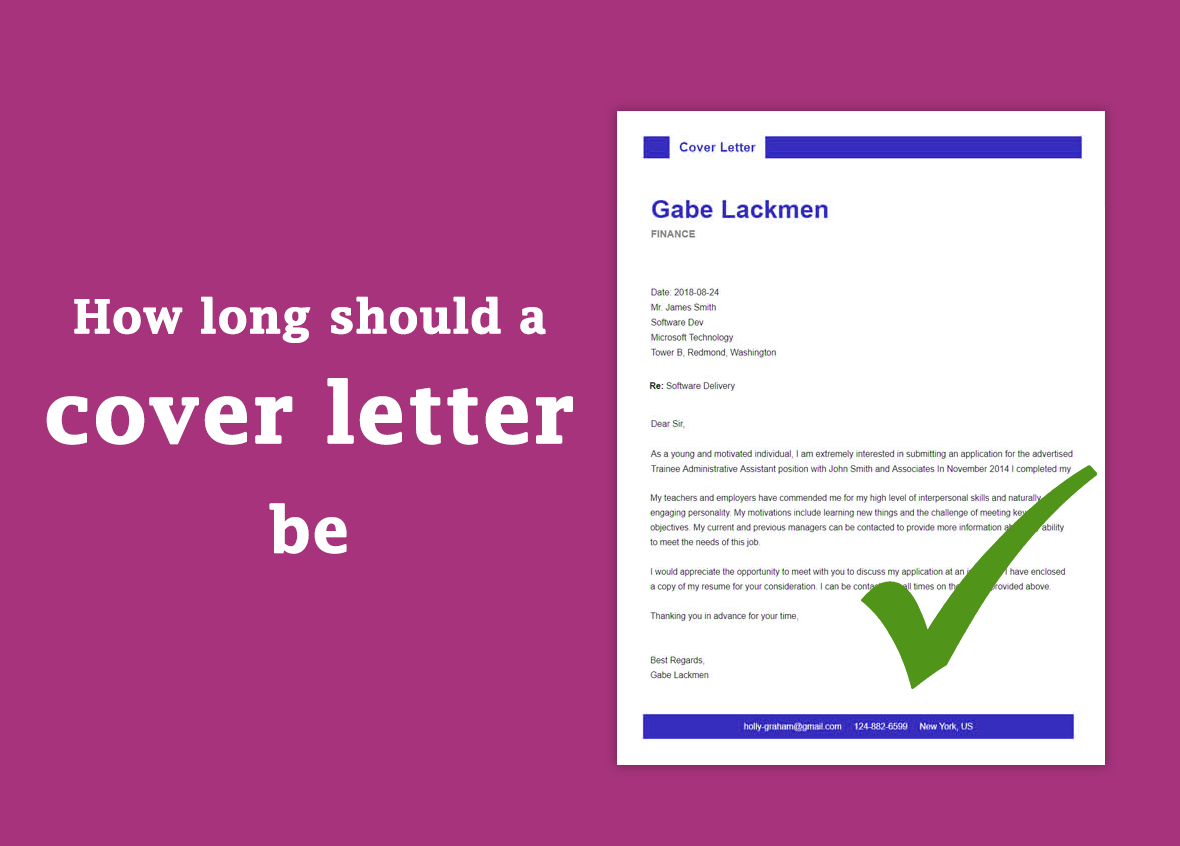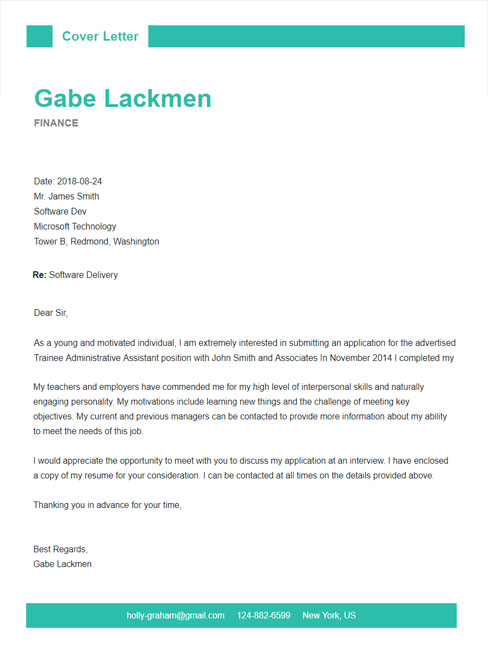
A cover letter should be a one-page document that highlights your most important qualifications for the position you are applying to. It should also demonstrate how you will make a positive contribution to the company if employed.
Length of cover letter: Less than one page.
Information about what’s required in a cover letter: See examples and additional resources below.
Your cover letter explains why you would make a good addition to the team and how you can make your job as easy as possible for others.
If you had a short paragraph that basically said why this job was perfect for you, that would be the first sentence. The rest of the letter is elaboration.
Example:
I am writing in response to the position of Executive Assistant advertised on LinkedIn. As a top performer from IBM and Salesforce, I have extensive experience handling high volumes of e-mail, managing calendars and arranging travel schedules, and much more. I am confident my skills would be an asset to any company at this time of economic growth.
When you start your cover letter you should use action verbs and present an enthusiastic and positive tone.
Example: I hope my letter demonstrates how I would be an asset to your company in relation to the position requirements. I look forward to hearing from you, Ms. _, at your earliest convenience.
A cover letter is more about you than it is about the person reading it, so make sure it highlights your experience and qualifications rather than repeating the job description verbatim.
You should also include the names of any contact information where the reader can reach you, such as a phone number, address, e-mail address, and LinkedIn name.
Always adhere to these few basic rules when writing your cover letter –
- Be concise and to the point: Cover letters shouldn’t be more than one page. Try to stick to one-and-a-half (about two pages) max.
- Include your contact information: It is becoming increasingly important to include a way for the hiring manager to reach you. You can have an e-mail address, phone number, and mailing address on hand.
- Stand out: Despite all the competition for a job, it is imperative that you stand out in some way. In most cases, this has to do with industry experience and specific points that make you more qualified for the job than others might be.
- Don’t ask: Follow the advice of LinkedIn. If you don’t know whether your contact information should be included or not, it probably shouldn’t be.
Staying on top of all these changes and keeping up-to-date on the most current job listings is essential to finding a new job before your current position becomes filled.
Sample Cover Letter:
Ms. _
I am writing in response to the position of ___ that was advertised on LinkedIn. As a top performer from IBM and Salesforce, I have extensive experience handling high volumes of e-mail, managing calendars and arranging travel schedules, and much more. I am confident my skills would be an asset to any company at this time of economic growth.
I hope my letter demonstrates how I would be an asset to your company in relation to the position requirements. I look forward to hearing from you, Ms. __, at your earliest convenience.
Sincerely,
(name)

Cover Letter Writing Guide:
- Your introduction: This is where you grab the reader’s attention, and explain what your cover letter is about. Make sure to give specific examples of the skills you have and how they relate to the position.
- Your first sentence: You want to grab the reader’s attention right away so it should start off in an active voice and should not use words like “I” or “You.” Instead, use words like “Here is where you can find a list of my relevant experience.”
- The rest of the letter: Your body of the letter should be written in an enthusiastic and positive tone. If you find yourself outlining your experience, you might need to rewrite your cover letter.
- Conclusion: Your conclusion is where you sum up what the reader had learned by reading through your cover Letter and what it means for them. This paragraph is also a good place to summarize anything about the job that was not mentioned in your introduction.
- References: You must include a list of your references along with your contact information and any other pieces of information that might be useful to the reader.
- Closing thoughts: This section can be used for anything you want to communicate that is not covered in the body of the letter.
Cover Letter Formatting Tips:
- Cover letter length: One page.
- There should be no “Dear Sir or Madam,” only “To Whom it May Concern.”
- There should NOT be a title for the resume, only the heading: “Curriculum Vitae” at the top of the first page.
- The date should be in the center of the page, and typed under your full name. This is a very formal document, so you should use a very professional format.
- There should be only one page inside the cover letter.
- The address should be written as follows: “To Whom It May Concern,” followed by the street address, city/state/zip code, and a return address (optional).
- Address every paragraph in the letter using the same format: “To Whom It May Concern.”
- Use 1 inch margins on all sides of the page.
- Use a 12-point font (but not so big that you use up too much space).
- Use Times New Roman or Arial; never use Comic Sans or other weird fonts.
- Include a header with your name, address, and phone number on one line, and then go down the page and leave four blank lines — this is where the HR department will write their comments when they mail it back to you.
- Double-space the entire letter, including the cover, address, and any comments from your future employer.
6 Things NOT to do in a cover letter:
- Never repeat your resume in your cover letter. It’s not necessary, and it makes the document more difficult to read.
- Don’t use a fake name or different email address when applying for jobs than you do in real life — this is, of course, unless you’re applying for an online job with an online company!
- Don’t write about how great your last boss was and how much you loved the job. It’s important to know that you will be a good fit for the company, but it’s just as important to know that you’ll be a good fit with your boss.
- Don’t make promises on behalf of your boss. You might think you have this great idea that will save the company money, but it’s not your place to suggest this idea to them.
- Don’t use clichés, buzzwords or nonsense phrases like “innovative,” “hardworking” and the like.
- Don’t write someone else’s cover letter. If you have a friend or a colleague who wrote a similar cover letter, you can ask them for advice on how to change it to make it unique. But do not write the same cover letter twice!
Key Takeaways:
- The ideal length of your cover letter should be one page.
- Your cover letter should be clear and concise, not filled with unnecessary verbiage.
- Don’t include your resume in your cover letter unless requested to do so.
- List all pertinent accomplishments on the first page of your cover letter to make it easier to skim
- If you have a written thank you note for the person who referred you, include that as well.
Recommended Reading:

